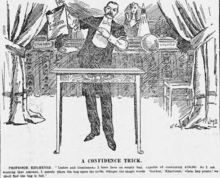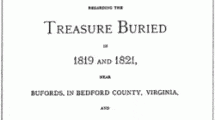Attempt to defraud a person or group after first gaining their confidence
A confidence trick is an attempt to defraud a person or group after first gaining their trust. Confidence tricks exploit victims using their credulity, naïveté, compassion, vanity, confidence, irresponsibility, and greed. Researchers have defined confidence tricks as “a distinctive species of fraudulent conduct […] intending to further voluntary exchanges that are not mutually beneficial”, as they “benefit con operators (‘con men’) at the expense of their victims (the ‘marks’)”.[1]
Terminology[edit]
Synonyms include con, confidence game, confidence scheme, ripoff, scam, and stratagem. The perpetrator of a confidence trick (or “con trick”) is often referred to as a confidence (or “con”) man, con-artist, or a “grifter”. The shell game dates back at least to Ancient Greece.[2]
Samuel Thompson (1821–1856) was the original “confidence man”. Thompson was a clumsy swindler who asked his victims to express confidence in him by giving him money or their watch rather than gaining their confidence in a more nuanced way. A few people trusted Thompson with their money and watches.[3] Thompson was arrested in July 1849. Reporting about this arrest, James Houston, a reporter for the New York Herald, publicized Thompson by naming him the “Confidence Man”.[3] Although Thompson was an unsuccessful scammer, he gained the reputation as a genius operator mostly because Houston’s satirical tone was not understood as such.[3] The National Police Gazette coined the term “confidence game” a few weeks after Houston first used the name “confidence man”.[3]
A confidence trick is also known as a con game, a finesse, a con, a scam, a grift, a hustle, a bunko (or bunco), a swindle, a flimflam, a gaffle, or a bamboozle. The intended victims are known as marks, suckers, stooges, mugs, rubes, or gulls (from the word gullible). When accomplices are employed, they are known as shills.
Length[edit]
A short con or “small con” is a fast swindle which takes just minutes, possibly seconds. It typically aims to rob the victim of money or other valuables which they carry on their person or are guarding.[4]
A “long con” or “big con” (also, chiefly British English: long game)[5] is a scam that unfolds over several days or weeks; it may involve a team of swindlers, and even props, sets, extras, costumes, and scripted lines. It aims to rob the victim of huge sums of money or valuables, often by getting them to empty out banking accounts and borrow from family members.[6]
In Confessions of a Confidence Man, Edward H. Smith lists the “six definite steps or stages of growth” of a confidence game.[7] He notes that some steps may be omitted. It is also possible some can be done in a different order than the one shown or carried out simultaneously.
Foundation work
Preparations are made in advance of the game, including the hiring of any assistants required and studying the background knowledge needed for the role.
Approach
The victim is approached or contacted.
Build-up
The victim is given an opportunity to profit from participating in a scheme. The victim’s greed is encouraged, such that their rational judgment of the situation might be impaired.
Pay-off or convincer
The victim receives a small payout as a demonstration of the scheme’s purported effectiveness. This may be a real amount of money or faked in some way (including physically or electronically). In a gambling con, the victim is allowed to win several small bets. In a stock market con, the victim is given fake dividends.
The “hurrah”
A sudden manufactured crisis or change of events forces the victim to act or make a decision immediately. This is the point at which the con succeeds or fails. With a financial scam, the con artist may tell the victim that the “window of opportunity” to make a large investment in the scheme is about to suddenly close forever.
The in-and-in
A conspirator (in on the con, but assumes the role of an interested bystander) puts an amount of money into the same scheme as the victim, to add an appearance of legitimacy. This can reassure the victim, and give the con man greater control when the deal has been completed.
In addition, some games require a “corroboration” step, particularly those involving a fake, but purportedly “rare item” of “great value”. This usually includes the use of an accomplice who plays the part of an uninvolved (initially skeptical) third party, who later confirms the claims made by the con man.[7]
Vulnerability factors[edit]
Confidence tricks exploit characteristics such as greed, dishonesty, vanity, opportunism, lust, compassion, credulity, irresponsibility, desperation, and naïvety. As such, there is no consistent profile of a confidence trick victim; the common factor is simply that the victim relies on the good faith of the con artist. Victims of investment scams tend to show an incautious level of greed and gullibility, and many con artists target the elderly and other people thought to be vulnerable, using various forms of confidence tricks.[8] Researchers Huang and Orbach argue:[1]
Cons succeed for inducing judgment errors—chiefly, errors arising from imperfect information and cognitive biases. In popular culture and among professional con men, the human vulnerabilities that cons exploit are depicted as ‘dishonesty’, ‘greed’, and ‘gullibility’ of the marks. Dishonesty, often represented by the expression ‘you can’t cheat an honest man’, refers to the willingness of marks to participate in unlawful acts, such as rigged gambling and embezzlement. Greed, the desire to ‘get something for nothing’, is a shorthand expression of marks’ beliefs that too-good-to-be-true gains are realistic. Gullibility reflects beliefs that marks are ‘suckers’ and ‘fools’ for entering into costly voluntary exchanges. Judicial opinions occasionally echo these sentiments.
Accomplices, also known as shills, help manipulate the mark into accepting the perpetrator’s plan. In a traditional confidence trick, the mark is led to believe that he will be able to win money or receive some benefits by doing some task. The accomplices may pretend to be strangers who have benefited from performing similar tasks in the past.[citation needed]
Going online[edit]
With the rise of the Internet, fraud has rapidly gone online. The Internet Crime Complaint Center (IC3) of the FBI received 847,376 reports in 2021 with a reported loss of money of $ 6.9 billion in the US alone.[9] The Global Anti Scam Alliance annual Global State of Scam Report, stated that globally $ 47.8 billion was lost and the number of reported scams increased from 139 in 2019 to 266 million in 2020.[10]
Government organizations have set-up online fraud reporting websites to build awareness about online scams and help victims make reporting of online fraud easier. Examples are in the US (FBI IC3, Federal Trade Commission), Australia (ScamWatch ACCC), Singapore (ScamAlert), United Kingdom (ActionFraud), Netherlands (FraudeHelpdesk). In addition, several private, non-profit initiatives have been set-up to combat online fraud like AA419 (2004), APWG (2004) and ScamAdviser (2012).
See also[edit]
References[edit]
^ a b Huang, Lindsey; Orbach, Barak (2018). “Con Men and Their Enablers: The Anatomy of Confidence Games”. Social Research: An International Quarterly. 85 (4): 795–822. doi:10.1353/sor.2018.0050.
^ “Shell Game.” Encyclopædia Britannica. https://www.britannica.com/EBchecked/topic/539702/shell-game
^ a b c d Braucher, Jean; Orbach, Barak (2015). “Scamming: The Misunderstood Confidence Man”. Yale Journal of Law & Humanities. 72 (2): 249–292. doi:10.2139/ssrn.2314071. S2CID 148270133.
^ Maurer 1999, Ch. 8. Short-Con Games
^ Yagoda, Ben (June 5, 2012). “The long game”. Not One-off Britishisms. Archived from the original on July 7, 2014. This language blog, while not a reliable etymological source, provides statistically gathered usage data that demonstrates neutral as well as critical usage, and that it is of British origin, only recently making notable inroads into American English.
^ Reading 2012, Ch. 1. Confidence
^ a b Smith, Edward H. (1923). Confessions of a Confidence Man: A Handbook for Suckers. Scientific American Publishing. pp. 35–37.
^ Crimes-of-persuasion.com Archived 2007-04-15 at the Wayback Machine Fraud Victim Advice / Assistance for Consumer Scams and Investment Frauds
^ “Internet Crime Report, 2021” (PDF). Internet Crime Complaint Center, FBI. Archived (PDF) from the original on 2022-03-22.
^ Greening, James (2021-12-07). “Scammers are Winning: € 41.3 ($ 47.8) Billion lost in Scams, up 15%”. GASA. Retrieved 2022-05-19.
Further reading[edit]
Bell, J. Bowyer; Whaley, Barton (1982). Cheating and Deception (reprint 1991). Transaction Publishers. ISBN 978-0887388682.
Blundell, Nigel (1984) [1982]. The World’s Greatest Crooks and Conmen and other mischievous malefactors. Octopus Books. ISBN 978-0706421446.
Dillon, Eamon (2008) [2008]. The Fraudsters: Sharks and Charlatans – How Con Artists Make Their Money. Merlin Publishing. ISBN 978-1903582824.
Ford, Charles V. (1999) [1999]. Lies! Lies!! Lies!!!: The Psychology of Deceit. American Psychiatric. ISBN 978-0880489973.
Henderson, Les (2000). Crimes of Persuasion: Schemes, scams, frauds. Coyote Ridge. ISBN 978-0968713303.
Kaminski, Marek M. (2004). Games Prisoners Play. Princeton: Princeton University Press. ISBN 978-0691117218.
Konnikova, Maria (2016). The Confidence Game: Why We Fall for It…Every Time. ISBN 978-0525427414.
Lazaroff, Steven & Rodger, Mark (2018) [2018]. History’s Greatest Deceptions and Confidence scams. Rodger & Laz Publishing S.E.N.C. ISBN 978-1775292128.{{cite book}}: CS1 maint: uses authors parameter (link)
Maurer, David W. (1999) [1940]. The Big Con: The Story of the Confidence Man and the Confidence Game. Bobbs Merrill / Anchor Books. ISBN 978-0385495387.
Maurer, David W. (1974). The American Confidence Man. Springfield: Charles C. Thomas, Publisher. ISBN 978-0398029746.
Reading, Amy (2012). The Mark Inside: A Perfect Swindle, a Cunning Revenge, and a Small History of the Big Con. Knopf. ISBN 978-0307473592.
Smith, Jeff (2009). Soapy Smith: The Life and Death of a Scoundrel. Juneau: Klondike Research. ISBN 978-0981974309.
Sutherland, Edwin Hardin (1937). The Professional Thief (reprint 1989). University of Chicago Press. ISBN 978-0226780511.
Weil, J.R. “Yellow Kid” (1948) [2004]. Con Man: A Master Swindler’s Own Story. Broadway Books. ISBN 978-0767917377.
Zhang, Yingyu (2017). The Book of Swindles: Selections from a Late Ming Collection. Columbia University Press. ISBN 978-0231178631.
External links[edit]





